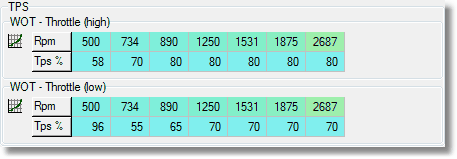These parameters control closed loop operation.
Closed Loop Operation
Closed loop operation controls the type of oxygen sensor / wideband used for closed loop operation.

| • | Disabled - open loop,. |
| • | Narrowband (Primary Oxygen Sensor) - stock setting for a PRA ECU. |
| • | Narrowband (Secondary Oxygen Sensor) - uses a narrowband sensor on the secondary input. Used for KPro/S2000 PRB ECUs using the S2000 stock narrowband sensor. |
| • | Built in wideband - stock setting for PRB, PNF, PRD ECUs. |
| • | External wideband - uses an external wideband (connected to the KPro analog input) for closed loop operation. Used for PRA calibrations wishing to run from a wideband or PRB calibrations without a factory oxygen sensor. External widebands must use a built in wideband conversion in order to run in closed loop. |
For vehicles without oxygen sensors closed loop should be disabled. While tuning closed loop should be disabled, otherwise the ECU will adjust the air/fuel ratio resulting in an inconsistent air/fuel ratio. The best way to do this is to set both the minimum and maximum short term trim adjustments to 0.
Closed Loop Options

Secondary oxygen sensor - disable the secondary o2 sensor is not present.
Disable P1167 and P0134 DTCs for race vehicles without a primary oxygen sensor. Do not disable these DTCs if the primary o2 sensor is present.
P0135 (European ECUs only) - disable this error if running without an o2 sensor.
Disable fuel over-run cutoff delay - this disables the 0.5 second delay between closing the throttle and the fuel injectors being shut down under over-run conditions. Disable this if you experience a hesitating while shifting with large injectors or see the short term fuel trim go sharply negative while shifting.
Short Term Trim

The minimum and maximum short term adjustment sets the limits for the short term fuel trim. The values are expressed as a percentage adjustment of fuel eg. -10% means that the short term fuel trim will not remove more than 10% fuel from the table.
Narrowband Settings

Narrowband settings (PRA calibrations only) control the voltage where closed loop switches from rich to lean and lean to rich.
Closed Loop to Open Loop Switch - Load

Maximum Map for closed loop - this determines the maximum engine load for closed loop.
Closed Loop to Open Loop Switch - TPS

Closed Loop Max TPS controls the maximum throttle for closed loop operation. The high table is the closed to open loop point and the low table is the open to closed loop point.